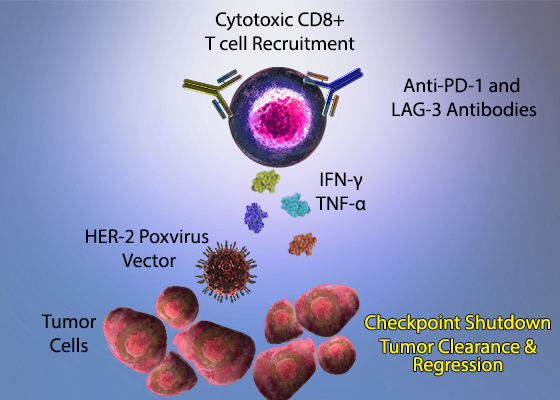 |
| Poxviruses have been used to encode tumor antigens (like HER-2) that can stimulate the immune system, drawing in IFN-γ and TNF-α producing CD8+ T cells that can increase the T effector:Treg ratio in the tumor microenvironment. In combination with this, antibodies can used to block immune checkpoints to prevent the immune cells’ shutdown. However, previous studies have indicated tumor cells can combat the blockade of one immune checkpoint by increasing expression of another. Foy et al. investigated a technique combining a poxvirus antigen system and antibodies against PD-1 and LAG-3. BioLegend specifically produces functional and pathogen-tested GoInVivo™ antibodies that aid in the study of immune checkpoint blockade, releasing several new antibodies over the past year. |

Adapted from Foy, S.P. et al. 2016. PLoS One. 11:e0150084. Pubmed |
| A MVA-BN-HER2 vector is used to express the HER-2 antigen that draws in CD8+ T cells that generate IFN-γ and TNF-α. However, tumor cells (and even other T cells) counter this by upregulating PD-L1 to shut down T cells. If HER-2 treatment was combined with PD-1 blockade, T cells then increased LAG-3 expression (which binds to MHC II and negatively regulates T cell activation) and tumor growth could be observed in half of the mice tested. As a result, Foy et al. used a combination of HER-2 vector and LAG-3 and PD-1 blocking antibodies. This treatment enabled complete tumor regression in their mouse model and provides insight to how immune checkpoints can be influenced by various treatments. |



 Login / Register
Login / Register 






Follow Us